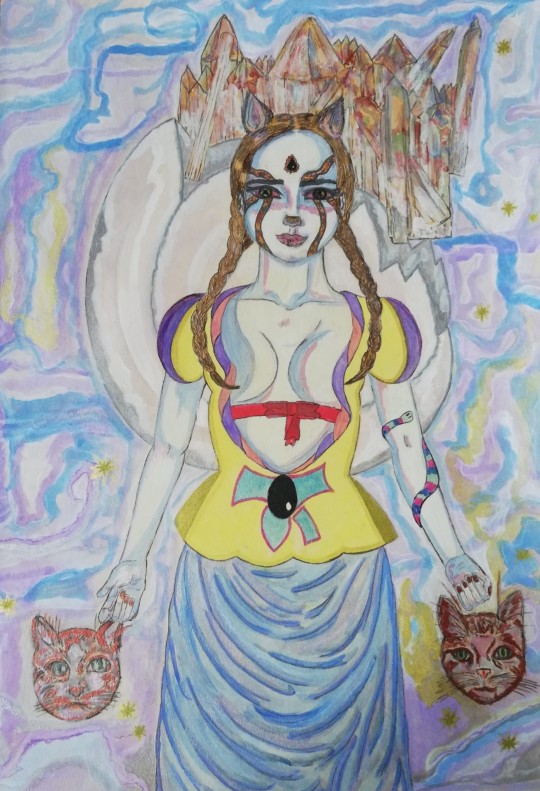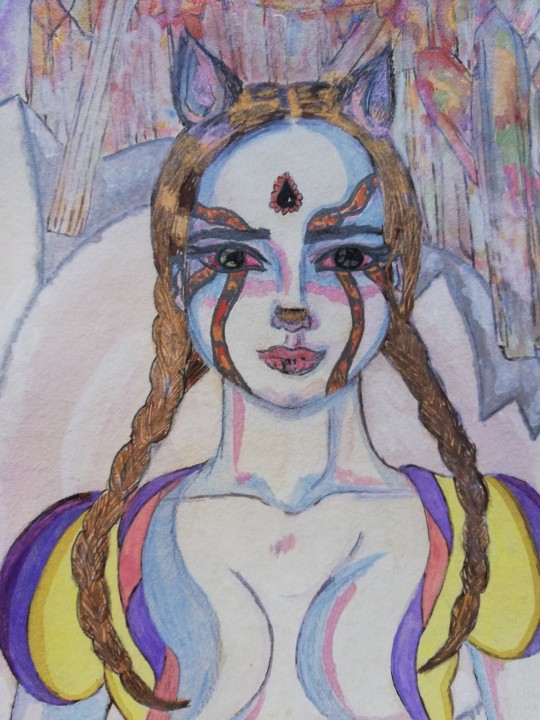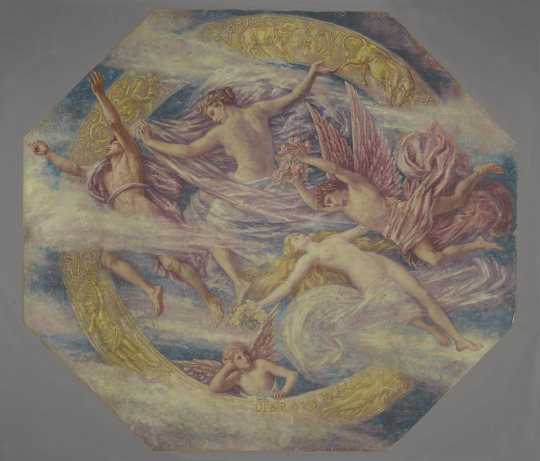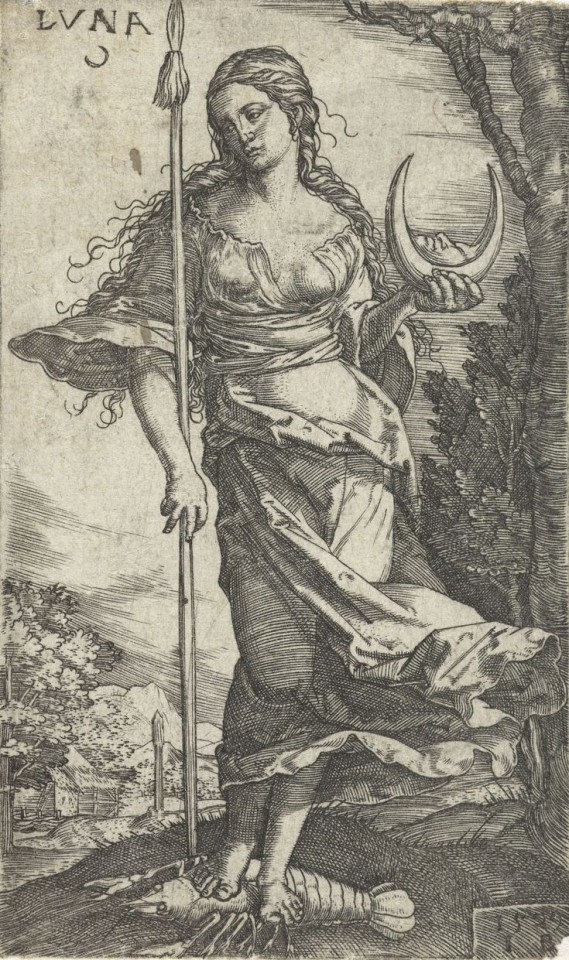Text



Cat Woman by Vera Bousiou, 2024.
Female myths, mysteries, rituals, and empowerment inspire my art as well as thinking a great deal. A timeless and empowered femininity as natural cycles and seasons touch the collective psyche. I'd say that "The White Goddess", by Robert Graves, or "Women's Mysteries" by Esther Harding, are two of the influences for this artwork, an impression of ancient Minoan Mysteries or those of holy Samothrace. Please support original art.
#mythology#art#symbolism#divine feminine#feline#artists on tumblr#female artists#goddess#mysticism#cosmic egg#gemstones#illustration#contemporary art#rituals
11 notes
·
View notes
Photo

The capture of the Ceryneian Hind (‘Ελαφος Κερυνῖτις) was the third labour of Herakles. The magical and divine hind with the golden antlers was sacred to the goddess of hunt and twin sister of Apollo, Artemis. One could see the divinity of the goddess herself in the wondrous creature who could run endless distances without rest. Herakles wasn’t meant to kill the hind just to capture her. This chase led Herakles to foreign lands and lasted one whole year, a symbolic duration evident of the initiations the hero went through during this time. Herakles reached the mysterious and enigmatic land of Hyperborea while being after the hind of Artemis, a place of superior magic whose patron deity was Apollo, the god of music and prophecy.
The deer is a symbol of the divine feminine element, spiritual superiority, sensitivity and is also linked to otherworldly and fairy realms, if one is following the deer he’s/she’s following the knowledge of the great mysteries, and that’s exactly what Herakles did in this labour.
Herakles breaking off the golden antler of the Ceryneian Hind, while Athena (left) and Artemis look on (black-figure amphora, ca. 540-530 BC).
#herakles#labour#mythology#ceryneian hind#deer#symbolism#ancient art#greek amphora#myth analysis#hyperborea#initiation#spirituality#heracles#greek myths
259 notes
·
View notes
Text

Francis Lathrop, Diana and Her Attendants among the Constellations, 1926.
#art#symbolism#mythology#diana#artemis#constellations#american art#painting#oil on canvas#francis lathrop
42 notes
·
View notes
Photo

~Longing by itself cannot transform a shadow into a living being again~
Orpheus and Eurydice by Edmund Dulac, 1935.
369 notes
·
View notes
Photo

Orpheus’ Sorrow by Pascal Adolphe Jean Dagnan-Bouveret, 1876.
#orpheus#mythology#lament#pascal adolphe jean dagnan-bouveret#art#19th century#naturalism#greek hero#mysticism
167 notes
·
View notes
Text

"Minoan Goddess", 2023. Gouache and ink on paper.
This illustration draws inspiration from the ancient Minoan femininity with a futuristic point of view. Is she Ariadne, the Lady of the Labyrinth, a goddess turned heroine, or a Minoan woman celebrating both her sensuality and dynamism? I can only wonder myself.
#art#symbolism#mysticism#mythology#spirituality#divine feminine#minoan goddess#ariadne#illustration#gouache#vera bousiou#mystical#artwork#artists on tumblr#mythology of the poet and the muse#inspiration
31 notes
·
View notes
Photo

Birth of Erichthonius. Athena receives the infant Erichthonius from Gaea (Earth) while Hephaestus looks on from the right. Codrus Painter (c. 450 BCE). Attic red figure vase painting.
155 notes
·
View notes
Text

Diana engraving, 1529, Rijksmuseum.
96 notes
·
View notes
Photo
One of the Orphic hymns I know by heart in ancient Greek:
Δεῦρο, Τύχη· καλέω σ᾽, ἀγαθῶν κράντειραν, ἐπευχαῖς, μειλιχίαν, ἐνοδῖτιν, ἐπ᾽ εὐόλβοις κτεάτεσσιν, Ἄρτεμιν ἡγεμόνην, μεγαλώνυμον, Εὐβουλῆος αἵματος ἐκγεγαῶσαν, ἀπρό<σ>μαχον εὖχος ἔχουσαν, τυμβιδίαν, πολύπλαγκτον, ἀοίδιμον ἀνθρώποισιν. ἐν σοὶ γὰρ βίοτος θνητῶν παμποίκιλός ἐστιν· οἷς μὲν γὰρ τεύχεις κτεάνων πλῆθος πολύολβον, οἷς δὲ κακὴν πενίην θυμῶι χόλον ὁρμαίνουσα. ἀλλά, θεά, λίτομαί σε μολεῖν βίωι εὐμενέουσαν, ὄλβοισι πλήθουσαν ἐπ᾽ εὐόλβοις κτεάτεσσιν.

Orphic hymn to Tyche (Fortune)
The Fumigation from Frankincense.
Approach strong Fortune [Tykhe], with propitious mind and rich abundance, to my pray'r inclin’d
Placid, and gentle Trivia, mighty nam’d, imperial Dian [Artemis], born of Pluto [Eubouleos] fam’d;
Mankind’s unconquer’d, endless praise is thine, sepulch'ral, widely-wand'ring pow'r divine!
In thee, our various mortal life is found, and some from thee hi copious wealth abound;
While others mourn thy hand averse to bless, in all the bitterness of deep distress.
Be present, Goddess, to thy vot'ry kind, and give abundance with benignant mind.
Tyche with young Ploutos and Cornucopia statue, Istanbul Archaelogical Museum.
#tyche#fortune#orphic hymns#ancient greece#abundance#greek goddess#prayer#ancient art#mythology#statue#blessings#hellenism#τυχη
78 notes
·
View notes
Text

Hermes with the apple of Eris (discord), from the Tales of the Greeks and Trojans, illustrated by Janet and Anne Grahame Johnstone, 1963.
#hermes#mythology#art#symbolism#ancient greece#greek gods#greek mythology#apple#eris#judgement of paris#vintage illustration#caduceus#old books
130 notes
·
View notes
Photo
Arcadia, a symbol of lost innocence or paradise for those loving symbolism and mysticism.

Lalique Antique Glass Arcadie Necklace.
#rene lalique#fine jewelry#art nouveau#mythology#mythological theme#arcadia#necklace#archetypes#symbolism
878 notes
·
View notes
Text
It's always interesting to find modern interpretations of the mythical, it certainly proves that it is something alive that keeps on moving the imagination and psyche of people. Lalique's work was exquisite, showing great creativity and sensitivity, things do not have to just be practical but also beautiful, we are not just material beings but also eternal; glimpses of beauty do guarantee that in the here and now. The myth of the Danaides or Belides is tragic; the fifty names of these brides differing from narration to narration, only one of them sparing her husband's life. The vase shows their punishment, the everflowing element is being showed with grace instead of tiredness.

René Lalique, "Danaides" vase, opalescent glass, 1926.
#symbolism#mythology#greek myths#danaides#rene lalique#glass#vase#opalescent#art deco#art nouveau#high aesthetics#elegance
407 notes
·
View notes
Photo
Happy 2024 everyone, may a new consciousness arise, on a personal and collective level!

The alchemical order demands the process of ‘Solve et Coagula’, a dissolution of false perceptions, prejudices, misunderstandings so that a new formation of ‘elements’ will take place within the individual consciousness, so a new sequence of ideas and notions will come to serve one’s way towards enlightenment, if that’s the goal…a finer understanding of life and its mechanisms, where the body becomes spiritual and the spirit becomes corporeal beyond polarities and disputes. A place or state where emptiness is form and form is emptiness, the unmanifested is also evident while the apparent is also elusive. The existential riddle of “Who I am?” still remains, the mystery of mysteries, but it is the formulation of this primordial question that becomes more elaborate. There’s immortality in mortality, as everything emanates from the same Source and everything will eventually return to it, and there’s the darkest of darkness, our fear of death and the unknown that could also be described as ‘infinite Light’.
Swan by Hilma af Klint, 1914.
#alchemy#solve et coagula#spirituality#consciousness#hilma af klint#enlightenment#2024#individuation#awareness#peace#inner life#psyche
737 notes
·
View notes
Photo

Way back in time when philosophy made its virginal steps, Greek philosopher Empedocles from Acragas, Sicily (450 B.C.) named the four roots of material existence, the four principals that without their participation nothing could exist in this world, the legendary four elements: Air, Fire, Water and Earth. The elements (στοιχεία) flooded the ancient thinking when arranging the analogies of cosmic phenomena and found their way to medieval alchemy and modern times neopaganism. Those life sustaining components can be linked to the four directions, to certain colors and deities, and even to specific characteristics of the human personality. Their combinations form the differences in the quantities and qualities of things, as Empedocles also proposed, two powers are responsible for the blending and circulation of the elements, Love and Strife, unison and separation. Balancing and understanding their effects can lead to awakening, as the Tantric tradition of the seven chakras believes, the elements are vital energies ruling our body and soul.
Vera Bousiou
Abundance and the Four Elements by Jan Brueghel the Elder and Hendrick de Clerk, 1606.
#ancient greek philosophy#philosophy#spirituality#four elements#empedocles#alchemy#paganism#article#tantra#art#jan brueghel the elder#cornucopia#wicca#gnosis#esoterica#hermeticism
148 notes
·
View notes
Text

A marble relief of Isis-Demeter from the facade of the main temple of the sanctuary of Isis. 2nd century BC.
Dion Archaeological Museum.
#dion#greek museums#isis#demeter#divine feminine#fertility#archetypes#mythology#greece#ancient art#relief#symbolism#greek gods#macedonian
25 notes
·
View notes
Text
Someone wanted to present this post as their own removing my blog's name and traces and using theirs, that is definitely lame, undignified, yet you see people I have actually read "Memories, Dreams, Reflections", and this isn't just a quote for me but also reflects my own life journey and how I was being perceived, the struggle and the transcendence...
“As a child I felt myself to be alone, and I am still, because I know things and must hint at things which others apparently know nothing of, and for the most part do not want to know. Loneliness does not come from having no people about one, but from being unable to communicate the things that seem important to oneself, or from holding certain views which others find inadmissible.”
— Carl Jung, “Memories, Dreams, Reflections”
2K notes
·
View notes
Photo
Herakles' first name was probably Alcaeus (the strong one), a name resembling that of his earthly mother which was Alkmene. When he ascends to heavens, to Olympus, after his many trials and tragic death, Hera, his former enemy or nemesis, becomes his second mother. It is obvious that the myth is quite metaphorical, echoing inner struggles and battles and the final psychological unison or completion of the hero.

Hera breastfeeding Hercules, by Johan Niclas Byström, 1818.
Is this staue a paradox? How is it possible Hera being Hercules’ worst enemy to appear as his mother here?…That’s perhaps what mainstream thinking would wonder about once acquainted with the myth. A myth though is something more fluid in interpretations than that. What we see here is also valid. Wasn’t Hercules honoring Hera with his feats after all? His name indicates his strong connection to the seemingly vindictive goddess, Hercules means “Hera’s glory”, the very destiny of the hero is associated with the goddess’ rage. That may signify a psychological process of maturation, trial and error and re-adjustment on the part of the hero. Hercules dies in agony, the fire consumes his aching body but his soul ascends to Olympus where Hera awaits for him and breastfeeds him, the Hero is being reborn and Hera becomes a nurturing “good breast” for him, a second mother, while she grants Hercules another gift, her daughter Hebe (youthfulness) as Hercules’ bride in heavens.
#ancient greek religion#mythology#greek mythology#hera#hercules#myth analysis#esoterica#psyche#transformations#herakles#psychology#completion#metaphor#breastfeeding#art#sculpture#psychoanalysis
164 notes
·
View notes